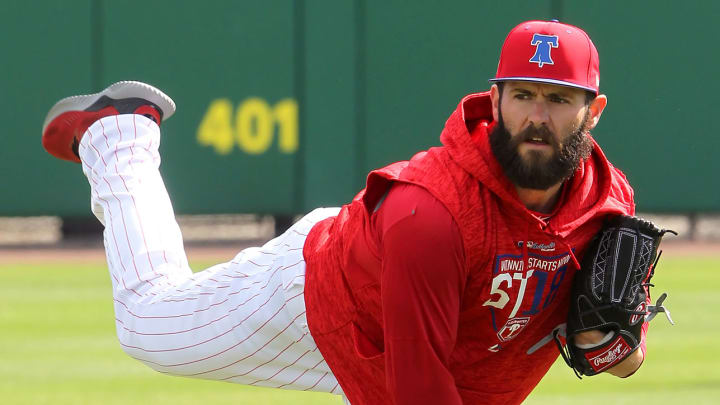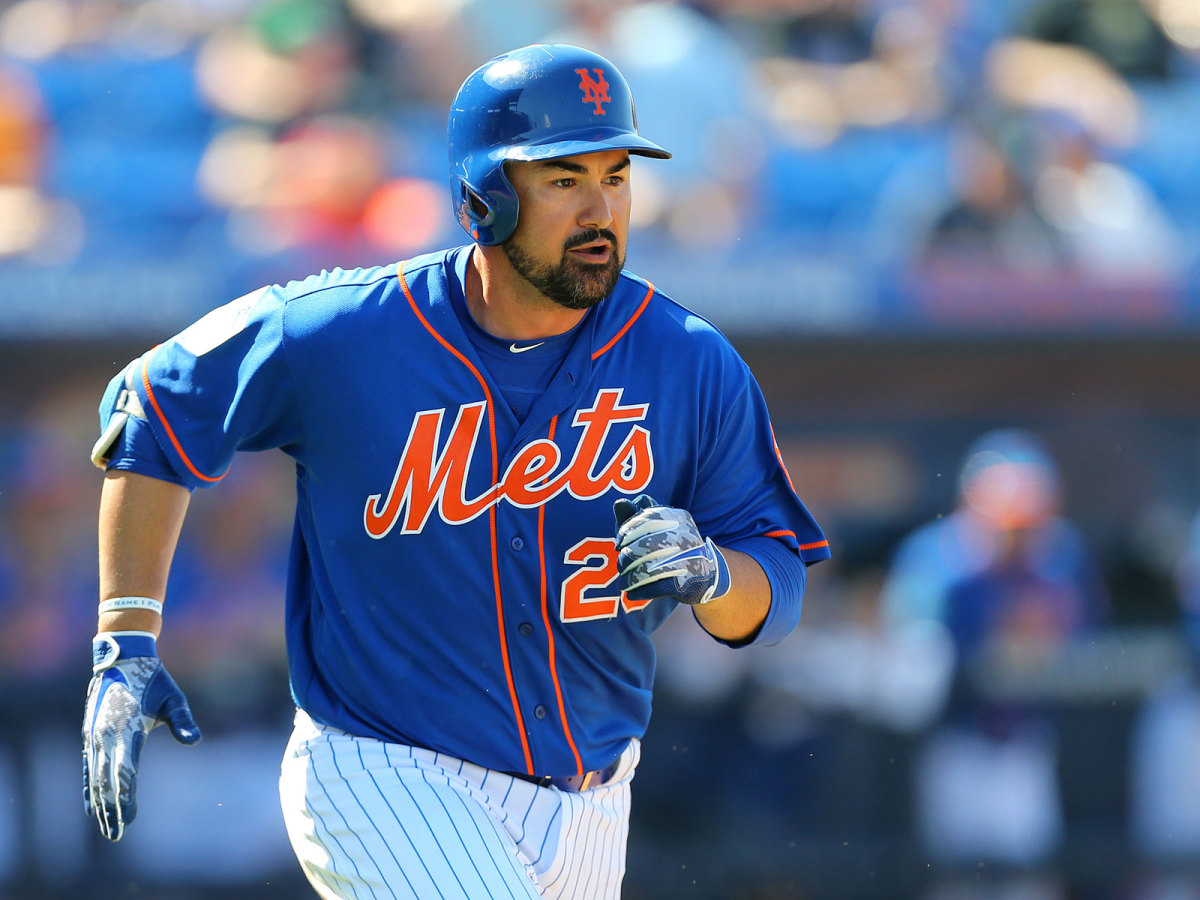One of the Major Offseason Winners Is the ... Phillies? Grading the NL East Winter Transactions

The offseason is over, spring training is in full swing, and despite a few notable names still available on the market, most if not all teams have called it quits in terms of signings and trades. So it’s time to look back on just what every squad did this winter and hand out grades for the moves made—or, in some cases, for those they failed to make. Next up: the National League East.
Players with an asterisk next to their name were re-signed as free agents.
Washington Nationals
2017 Record: 97–65, first place in NL East
Key Additions: 1B Matt Adams, OF Howie Kendrick*, RHP Brandon Kintzler*, C Miguel Montero
Key Departures: RHP Matt Albers, 1B Adam Lind, LHP Oliver Perez, OF Jayson Werth
Stymied once again by the first round of the playoffs, you might’ve expected the Nationals to go all out this offseason ahead of what could be their final year with Bryce Harper. Instead, Washington’s front office played it safe, choosing only to bring back Kendrick and Kintzler and replace Lind with Adams (smart moves, all). On one hand, that’s understandable: The Nationals are set, starter-wise, at every position, and for once, they have a bullpen that didn’t require a total overhaul. But it’s odd that the one area of need—the back of the rotation—went completely unaddressed despite a surfeit of cheap available options, particularly with starters like Lance Lynn and the still-available Alex Cobb languishing on the market for months. As it stands, righty A.J. Cole will get the first crack at the No. 5 spot, and while he was fine last year, he’d be better as depth than a counted-upon starter. The Nationals should win the East regardless, but it’s still surprising they weren’t a little more active this winter.
Grade: B
Miami Marlins
2017 Record: 77–85, second place in NL East
Key Additions: RHP Sandy Alcantara, OF Lewis Brinson, 2B Starlin Castro, OF Cameron Maybin, OF Magneuris Sierra
Key Departures: 2B Dee Gordon, OF Marcell Ozuna, OF Giancarlo Stanton, OF Ichiro Suzuki, RHP Edinson Volquez, OF Christian Yelich
Here are the positives, few and scattered, of this Marlins offseason. They got a few good prospects—namely Brinson, Alcantara and Sierra—in exchange for blowing up their All-Star outfield of Ozuna, Stanton and Yelich. They no longer have to figure out how to make Stanton’s gargantuan contract—the parting gift of loathsome ex-owner Jeffrey Loria—work financially. And, if nothing else, there will be no expectations placed upon them this year, save to lose and lose often. In exchange, all the franchise under new owners Bruce Sherman and Derek Jeter had to do was sacrifice any and all semblance of competing or behaving like a functional team that owes anything at all to its fans.
Grading the moves Miami made is almost beyond the point, because the entire reason that all those big names were traded wasn’t about wins and losses but simply to save money. A debt-saddled team was sold to a group of investors who couldn’t afford it—who then, in the vein of private equity firms all across the land, purged the roster of anything valuable so as to make things more profitable. The result is a sad, blasted team that will lose 100 games in the ugliest and most cynical fashion imaginable in the emptiest stadium in America. And for what purpose, exactly? Jeter and company will insist that these trades had to happen to make the Marlins functional in the future, but if you think that this cycle won’t repeat itself once those new players start getting expensive, then I’ve got a taxpayer-funded park in Little Havana to sell you.
Grade: F
Atlanta Braves
2017 Record: 72–90, third place in NL East
Key Additions: LHP Scott Kazmir, RHP Brandon McCarthy, 3B Ryan Schimpf
Key Departures: 1B Matt Adams, RHP R.A. Dickey, 3B Adonis Garcia, RHP Jim Johnson, OF Matt Kemp, 2B Jace Peterson
Not included in that list of departures is either ex-general manager John Coppolella or former top prospect Kevin Maitan, both gone after an MLB investigation revealed all kinds of international signing shenanigans on the part of Atlanta’s front office. That all happened in November, starting the Braves off on the worst possible foot this winter, but they never really bothered taking a step after that. The team’s only move of note was to function as a sort of on-field tax shelter for the Dodgers, taking on the contracts of Kazmir, McCarthy and, for about a day or so, Adrian Gonzalez in exchange for unloading Kemp and the $30 million or so left on his deal.
If healthy, Kazmir and McCarthy should add some needed rotation depth, but “if healthy” is doing a lot of work there, as neither pitcher has been that for a full season in years. Beyond that, the Braves did nothing, apparently deciding that, as a rebuilding squad, there was no point in doing anything at all. In truth, there was no real combination of signings or trades that would’ve resulted in Atlanta contending in 2018. But it’s still a brutal example of how messed up baseball’s financials currently are—that, instead of spending money and making an actual effort, losing teams are better off not trying at all. Maybe the good people of Cobb County, Ga., should’ve been told that was the plan before being forced to fork over $400 million in public funding two years ago to build the Braves a new stadium—a deal that’s already left the county facing a budget shortfall but doesn’t include a team spending the money it saved to try to win.
Grade: D

New York Mets
2017 Record: 70–92, fourth place in NL East
Key Additions: OF Jay Bruce*, 1B Adrian Gonzalez, 3B Todd Frazier, IF Jose Reyes*, RHP Anthony Swarzak, LHP Jason Vargas
Key Departures: OF Nori Aoki, LHP Tommy Milone, 3B Matt Reynolds
Yes, you’re reading that right: The Mets made actual moves this winter. Per usual, the biggest one—Bruce—was the return of a player that Fred Wilpon recognizes. But at least New York made some effort to improve a team that collapsed en route to its worst finish since 2009. Bruce is limited but productive, Frazier offers much-needed power at a position that beguiled the team all last year, and Swarzak is a sneaky good add to the bullpen. But despite an offseason practically designed for a team like the Mets—one in which a frigid market left impact free agents available on the cheap—the team didn’t do more than add those low-cost and low-ceiling options. And there are still trouble spots all over the roster: first base, currently a competition between the decrepit Gonzalez and the disappointing Dom Smith; second base, which belongs to decidedly average veteran Asdrubal Cabrera; and the back of the rotation, where the Mets contented themselves with adding unexceptional southpaw Vargas. That starting five is arguably the biggest worry, given how thoroughly all of New York’s once vaunted arms fell apart last season and how little depth there is for that oft-injured group. The Mets are likely counting on better health and return to form as the keys to contention. A little more activity in free agency or on the trade market, though, would’ve been a safer play.
Grade: B-
Philadelphia Phillies
2017 Record: 66–96, fifth place in NL East
Key Additions: LHP Fernando Abad, RHP Jake Arrieta, RHP Tommy Hunter, RHP Pat Neshek, 1B Carlos Santana
Key Departures: SS Freddy Galvis, OF Hyun-soo Kim, 1B Tommy Joseph
It’s not every winter you see a 96-loss team go after two premier free agents, but that’s what the Phillies did, taking advantage of the depressed market by signing Arrieta and Santana to discounted three-year deals. The fits aren’t perfect. Santana is a potent bat for the middle of the lineup, but he’ll force Philadelphia to move slugging sensation Rhys Hoskins from first base to the outfield, where he could struggle, and take playing time away from Aaron Altherr. Arrieta, meanwhile, won’t displace anyone important, but he’s a riskier bet than Santana given his decline over the last two seasons. Then again, neither financial outlay was substantial, particularly given that the Phillies have little to no long-term salary commitments otherwise. But while it’s unlikely that both those players plus veteran relievers Hunter and Neshek are enough to vault Philadelphia from the NL East basement to a wild-card spot, that doesn’t make those moves bad. The Phillies feel like they’ve reached the next step of their rebuild and that now’s the time to move, and even if they’re wrong, the fact that they’re making that effort at all is worth commending.
Grade: B+
